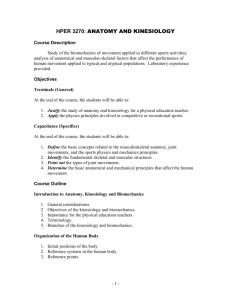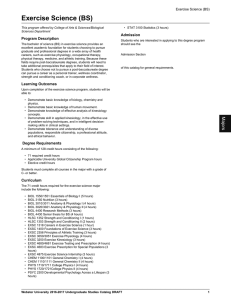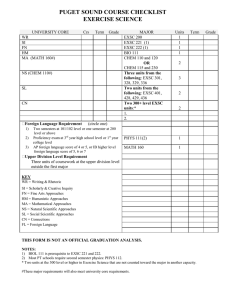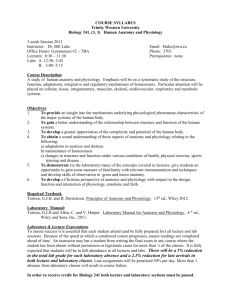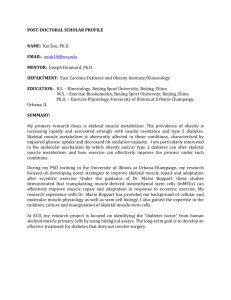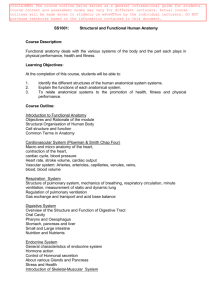Instructor:
advertisement
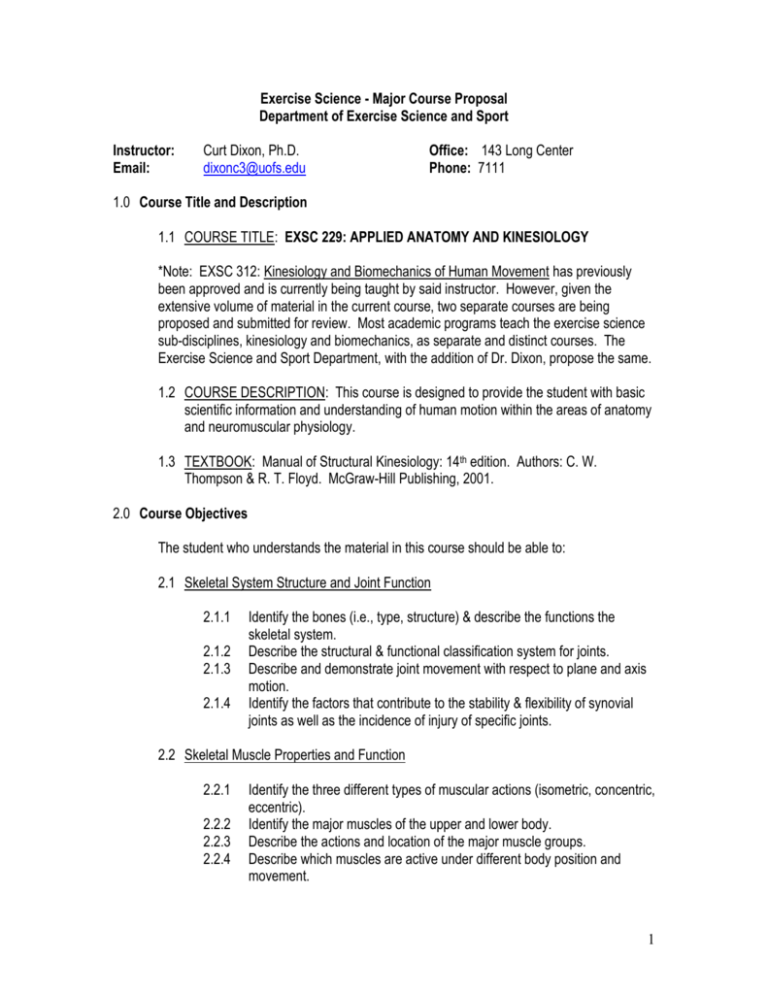
Exercise Science - Major Course Proposal Department of Exercise Science and Sport Instructor: Email: Curt Dixon, Ph.D. dixonc3@uofs.edu Office: 143 Long Center Phone: 7111 1.0 Course Title and Description 1.1 COURSE TITLE: EXSC 229: APPLIED ANATOMY AND KINESIOLOGY *Note: EXSC 312: Kinesiology and Biomechanics of Human Movement has previously been approved and is currently being taught by said instructor. However, given the extensive volume of material in the current course, two separate courses are being proposed and submitted for review. Most academic programs teach the exercise science sub-disciplines, kinesiology and biomechanics, as separate and distinct courses. The Exercise Science and Sport Department, with the addition of Dr. Dixon, propose the same. 1.2 COURSE DESCRIPTION: This course is designed to provide the student with basic scientific information and understanding of human motion within the areas of anatomy and neuromuscular physiology. 1.3 TEXTBOOK: Manual of Structural Kinesiology: 14th edition. Authors: C. W. Thompson & R. T. Floyd. McGraw-Hill Publishing, 2001. 2.0 Course Objectives The student who understands the material in this course should be able to: 2.1 Skeletal System Structure and Joint Function 2.1.1 2.1.2 2.1.3 2.1.4 Identify the bones (i.e., type, structure) & describe the functions the skeletal system. Describe the structural & functional classification system for joints. Describe and demonstrate joint movement with respect to plane and axis motion. Identify the factors that contribute to the stability & flexibility of synovial joints as well as the incidence of injury of specific joints. 2.2 Skeletal Muscle Properties and Function 2.2.1 2.2.2 2.2.3 2.2.4 Identify the three different types of muscular actions (isometric, concentric, eccentric). Identify the major muscles of the upper and lower body. Describe the actions and location of the major muscle groups. Describe which muscles are active under different body position and movement. 1 2.3 Neuromuscular Function 2.3.1 2.3.2 2.3.3 2.3.4 2.3.5 Describe the basic structures (i.e., motor unit, muscle spindle, golgi tendon organ, etc.) of the neuromuscular system. Describe the communication between neuron & muscle cell that produces human movement. Explain the processes (i.e., recruitment, summation) used by the central nervous system to control muscle force. Identify specific nerves responsible for innervating and activating major muscles. Describe the role of reflexes in controlling body position and movement. 3.0 Brief List of Topics to be Addressed in the Course: 3.1 Concepts, Principles & Terminology 3.2 Skeletal System 3.3 Muscular System 3.4 Nervous System 3.5 Single Joint Operation 3.6 Shoulder Complex 3.7 Elbow & Radioulnar Joints 3.8 Wrist & Hand 3.9 Vertebrae 3.10 Hip Joint 3.11 Knee Joint 3.12 Ankle & Foot 4.0 Brief List of Assignments and Evaluation 4.1 EXAMINATIONS: There will be THREE 60-minute exams, each accounting for 25% of the final course grade. Each exam will consist of a total of 100 possible points. Any objections concerning grading of exam must be brought to the intention of the instructor WITHIN 10 WORKING DAYS of the exam date. Grades will not be given over the phone. In case a student is unable to take an exam, he/she must inform the instructor as soon as possible. Unless a satisfactory explanation (e.g. illness, death of close relative, etc.) is provided, make-up exams will NOT be given and the student will receive a 0% grade for that exam. It is the student’s responsibility to arrange for any make-up exam with the instructor, but it must be taken within ten working days from the day the exam was originally scheduled. 4.2 LAB ASSIGNMENTS: 10% of the course grade will consist of a series of in-class laboratory assignments addressing topics covered in lecture including, the skeletal system (involving skeletons), goniometry/range of motion, muscle origin/insertion, and joint-specific motion analysis. 2 4.3 ANALYSIS OF MOTION PROJECT: 15% of the course grade will consist of the student’s analysis of a self-chosen, human movement (i.e., throwing a baseball, breaststroke, running, etc.). The kinesiological analysis of motion should include a detailed description of the muscles and muscular actions, associated joint(s) and movement patterns, and neurological principals (i.e., reflexes, co-contraction, etc.) involved in the motion. 4.4 Grades will be based on a % of the total points according to this scale: A = 93 and above A- = 90-92 B+= 88-89 B = 83-87 B- = 80-82 C+ = 78-79 C = 73-77 C- = 70-72 D+ = 68-69 D = 60-67 F = <60% 5.0 Prerequisites (if any): 5.1 EXSC 229: APPLIED ANATOMY AND KINESIOLOGY is the exploration of human motion via the integration of three basic biological systems (skeletal, muscular, nervous). A basic knowledge and understanding of human structure and function is crucial to the advanced principles covered in this course. As such, students will be required to complete BIO 110-111: Structure and Function of Human Body and EXSC 210: Sports Physiology prior to enrolling in this course. 6.0 Course Level 6.1 The proposed course, APPLIED ANATOMY AND KINESIOLOGY, is a 2nd year (sophomore standing) EXSC course. The anatomical and physiological principles covered during the 1st year courses (i.e. BIO 110-111: Structure and Function, EXSC 210: Sports Physiology) will provide students with a solid scientific foundation from which to build by analyzing human movement via applied anatomy. 7.0 Instructional Methods & Student Conduct 6.2 Instructional Methods: This course will incorporate lecture, small-group discussion, and in-class laboratory exercises. Students are strongly encouraged to actively participate in classroom discussion. 6.3 Student Conduct: Please show respect for your instructor and fellow classmates by arriving to class on time and not eating in class. Attendance is expected (please, don’t ask how many you can miss). Cell phones and pagers will not be allowed (turn them OFF, if you bring them to class). Finally, cheating of any kind will not be tolerated and will result in a 0%. 6.4 The instructor reserves the right to change any of the information provided in this syllabus, as needed. Students will be notified of any changes, immediately. 3

